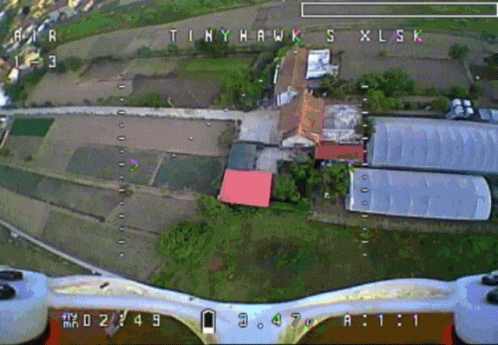
In today’s rapidly evolving world, unmanned aerial vehicles (UAVs) are emerging as both transformative technologies and lucrative targets for cyberattacks. This article presents an in-depth analysis of the intentional vulnerabilities present in a simulated drone environment, widely known as the Damn Vulnerable Drone (DVD) simulator. Designed for cybersecurity professionals, penetration testers, this article offers an exploration of drone vulnerabilities, simple exploitation techniques.

Overview
Drones have become ubiquitous in commercial, recreational, and military applications, transforming various industries with their diverse functionalities. However, the increased deployment of UAVs has simultaneously expanded the threat surface for cyberattacks. The DVD simulator, built on the ArduPilot and MAVLink architecture, is an open-source platform that replicates the vulnerabilities found in real-world drone systems. By providing a safe, controlled environment that leverages Software-in-the-Loop (SITL) technology, the simulator enables researchers to experiment with and analyze potential security weaknesses without the financial overhead or risks associated with physical drones.
The simulator’s integration with cutting-edge tools such as Gazebo for 3D robotics simulation, QGroundControl for mission planning, and MAVProxy for telemetry management underscores its relevance as a robust educational and testing tool. Moreover, the containerized Docker environment ensures that security experiments remain isolated and manageable.
Technical Analysis
The Damn Vulnerable Drone simulator represents a sophisticated intersection of open-source software, virtualization, and cybersecurity testing methodologies. Built to intentionally expose vulnerabilities, the simulator mimics real-world drone architectures by leveraging the popular ArduPilot firmware and the MAVLink communication protocol. Its architecture is designed to reflect the operational realities of modern drones, enabling detailed analysis of critical components such as wireless communication interfaces, onboard camera systems, and companion computer integrations.
One of the most significant advantages of the DVD simulator is its modular design, which allows researchers to customize scenarios and isolate specific vulnerabilities for testing. The platform’s reliance on Docker containers ensures that the simulation environment remains secure and consistent, enabling repeated testing without compromising host system integrity. This technical rigor positions the simulator as an invaluable resource for professionals seeking to understand both traditional and emerging attack vectors in drone cybersecurity.
Case Study: Wireless Network Attacks
Wireless communication forms the backbone of drone operations, but it also introduces critical vulnerabilities that can be exploited by malicious actors. The DVD simulator features a simulated WiFi interface that adheres to the 802.11 protocol, enabling users to experiment with common wireless attacks. Cybersecurity practitioners can simulate scenarios such as deauthentication attacks and man-in-the-middle (MITM) exploits, thereby gaining practical experience with the tools and techniques used by real-world attackers.
The simulator’s environment allows users to deploy popular tools like Aircrack-ng and Wireshark to capture, analyze, and manipulate drone communication packets. By intercepting and analyzing data transmissions, testers can identify weaknesses in the encryption protocols and network configurations commonly found in consumer and commercial drones. This hands-on experience not only helps in understanding the vulnerabilities inherent in wireless communications but also emphasizes the importance of robust encryption and secure communication channels in modern drone systems.
- Simulated 802.11 Environment: The platform accurately replicates the nuances of the 802.11 protocol, enabling detailed analysis of network behaviors and potential attack vectors that could compromise drone control and data integrity.
- Exploitation Tools Integration: By integrating tools such as Aircrack-ng and Wireshark within the simulator, researchers can execute and document a wide range of wireless attacks, thereby developing comprehensive mitigation strategies and robust countermeasures.
Case Study: Onboard Camera and Gimbal Exploitation
In addition to network vulnerabilities, the onboard camera and gimbal systems represent another critical area of interest for cybersecurity professionals. The DVD simulator includes a simulated RTSP camera stream, complete with gimbal and companion computer interfaces, to mirror the operational dynamics of modern drone surveillance systems. This setup allows penetration testers to explore vulnerabilities in video streaming protocols and the web interfaces that manage these systems.
Attackers may target the RTSP stream to intercept live video feeds or inject falsified data, potentially compromising situational awareness and operational integrity. Moreover, the companion computer’s web interface may be exploited for unauthorized access, command injection, or other forms of remote manipulation. These vulnerabilities highlight the dual threat of both data interception and active control compromise in modern drone systems.
- RTSP and Video Stream Vulnerabilities: The simulator demonstrates how attackers can exploit weaknesses in real-time streaming protocols, potentially intercepting or manipulating video data in transit. This exposes critical flaws in the current security implementations of drone surveillance systems.
- Companion Computer Interface Attacks: By focusing on the web interface of the companion computer, testers can simulate scenarios involving unauthorized access and command injection, thereby uncovering vulnerabilities that could lead to a complete takeover of the drone’s control system.
Methodology
The methodological framework behind the DVD simulator is designed to facilitate a granular exploration of drone vulnerabilities through a controlled yet flexible testing environment. The simulator employs a modular approach, where each component—ranging from wireless communication interfaces to onboard sensors—is isolated for focused testing. This modularity allows researchers to construct targeted attack scenarios, modify parameters, and observe the resulting impact on drone operations.
At the core of the simulator’s operation is the integration of Docker-based containerization, which ensures that each test environment remains secure and reproducible. The use of Software-in-the-Loop (SITL) technology enables the execution of drone firmware in a virtualized setting, thereby replicating the behavior of real drones without exposing physical hardware to risk. Additionally, the integration of simulation tools such as Gazebo provides a dynamic 3D environment that closely mimics real-world conditions, further enhancing the fidelity of security experiments.
The methodology extends to the integration of QGroundControl and MAVProxy, which are used to manage telemetry data and command transmissions. Through the MAVLink Router, users can forward telemetry to external analysis systems, facilitating advanced research into communication protocols and data integrity. This comprehensive framework not only supports the identification of vulnerabilities but also encourages the development of innovative countermeasures that can be applied to both simulated and real-world drone systems.
Integrating Broader Drone Cybersecurity Context
Recent research and industry reports have highlighted the unique cybersecurity risks associated with consumer drones. According to insights from reputable cybersecurity sources, many consumer-grade drones suffer from inadequate encryption, poorly secured communication protocols, and limited defenses against remote attacks. This situation is exacerbated by cost constraints that lead to compromises in the security architecture of these devices. The DVD simulator serves as a critical tool in this context by offering a realistic environment where such vulnerabilities can be systematically exploited and studied.
Beyond the technical aspects, drones have significantly influenced modern conflict and surveillance practices. Analyses from research organizations emphasize that drones have reshaped the nature of warfare, offering unprecedented capabilities for reconnaissance and targeted strikes. However, these advancements have also introduced ethical and legal challenges, particularly regarding collateral damage and privacy violations. The simulator’s controlled environment allows cybersecurity professionals to experiment with attack vectors that parallel those used in real-world conflicts, thereby informing both defensive strategies and policy frameworks.
Furthermore, forensic analysis techniques play an essential role in understanding drone strikes and their implications. Investigations into drone strike platforms have underscored the importance of detailed forensic methodologies to accurately reconstruct events, identify responsible parties, and prevent future incidents. The DVD simulator, by offering an accessible platform for forensic experimentation, contributes to the broader understanding of how drones can be both a tool for and a target of cyberattacks in complex conflict scenarios.
Limitations and Future Outlook
While the DVD simulator provides a robust platform for exploring drone vulnerabilities, it is important to acknowledge its limitations. The current iteration of the simulator is tailored primarily to a specific subset of drone architectures, which may not fully represent the diversity of real-world systems. Certain advanced configurations, proprietary communication protocols, and hardware-specific vulnerabilities remain outside the simulator’s scope. Despite these limitations, the open-source nature of the platform ensures that it can be continuously updated and expanded by the cybersecurity community.
Looking ahead, the integration of emerging technologies such as machine learning and artificial intelligence holds significant promise for enhancing the fidelity and scope of drone simulation environments. Future iterations of the simulator could incorporate adaptive threat models that dynamically adjust to simulated attack scenarios, thereby providing a more realistic and challenging environment for penetration testers. Additionally, the incorporation of quantum-resistant encryption algorithms may offer insights into next-generation security practices that can preemptively counteract sophisticated drone cyberattacks.
As the sophistication of drone technology continues to evolve, so too will the tactics employed by cyber adversaries. This ongoing arms race underscores the need for continuous research, rigorous testing, and proactive security measures. By leveraging platforms like the DVD simulator, cybersecurity professionals can stay ahead of emerging threats and contribute to the development of more resilient, secure drone systems.
Conclusion
The comprehensive analysis presented in this article underscores the critical importance of understanding and mitigating drone vulnerabilities. Through an in-depth exploration of the DVD simulator, cybersecurity professionals gain invaluable insights into the operational weaknesses of modern UAV systems. From wireless communication exploits to onboard camera and companion computer attacks, the technical methodologies discussed herein illustrate the multifaceted challenges associated with securing drone technologies.
Furthermore, by situating the DVD simulator within the broader context of consumer drone risks, modern conflict, and forensic investigations, this guide highlights the interdependencies between technological advancements and cybersecurity challenges. As drones continue to proliferate in both civilian and military domains, the need for rigorous security protocols and advanced testing methodologies becomes increasingly paramount.
Ultimately, the DVD simulator stands as a testament to the value of intentional vulnerability research in driving forward the field of drone cybersecurity. By enabling a controlled exploration of potential attack vectors, the simulator not only equips cybersecurity professionals with practical skills but also fosters a deeper understanding of the evolving threat landscape. Continued investment in research, development, and collaborative knowledge sharing will be essential in building resilient defenses against the sophisticated cyberattacks of tomorrow.

